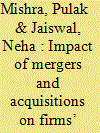|
|
|
Sort Order |
|
|
|
Items / Page
|
|
|
|
|
|
|
| Srl | Item |
| 1 |
ID:
144858


|
|
|
|
|
| Summary/Abstract |
Exchange rate movement usually results in changes in the production costs of exporting firms, and, therefore, the prices and the quantity of traded products. The present paper constructs a theoretical model to demonstrate that export products with higher productivity, or with larger market share, or of higher quality will experience a less complete pass-through. Using the six-digit harmonized system export data from the CEPII database over the period of 2000 to 2013, the present paper examines how product heterogeneity affects the exchange rate pass-through of Chinese exports. The empirical results show that the most competitive Chinese export products, or those least affected by exchange rate risks, are those of higher quality, with higher technological complexity and at the high end of the international value chain. Therefore, Chinese exporting firms should pay more attention to improving export quality and upgrading technology to better cope with exchange rate risks and to enjoy more bargaining power in the international market.
|
|
|
|
|
|
|
|
|
|
|
|
|
|
|
|
| 2 |
ID:
152804


|
|
|
|
|
| Summary/Abstract |
This article attempts to examine the impact of mergers and acquisitions (M&A) on export competitiveness of firms in Indian pharmaceutical industry. It finds that the wave of M&A has positive influence on both incidence and extent of export competitiveness. In addition, incidence of exports is positively influenced by market share and efforts towards creating marketing and distribution related complementary assets as well. On the other hand, the extent of export intensity is also higher for firms with larger market share, greater marketing and distribution-related efforts, innovation and foreign technology purchase. However, advertising and financial performance do not cause any significant impact on export competitiveness. It is, therefore, suggested that policies and regulations relating to M&A, innovation and sourcing foreign technology need a fresh look with greater industry-specific flexibilities. There is also a need for integration of different policies and regulations in areas like FDI, intellectual property, and so on.
|
|
|
|
|
|
|
|
|
|
|
|
|
|
|
|
| 3 |
ID:
155177


|
|
|
|
|
| Summary/Abstract |
The South Asian Association for Regional Cooperation (SAARC) region is
bestowed with geographical, historical and cultural continuity and yet it remains
one of the least integrated regions of the world. This article attempts to analyse
the factors inhibiting the economic integration of the region. The intra-SAARC
trade is analysed in view of the existence of a free trade agreement between the
member nations. The socio-development, infrastructural and economic indicators
of the nations are also compared. The reasons for the existence of mistrust
and hostility between the SAARC countries are discussed, from India’s
evident dominant position in the group as a cause for insecurity among other
members to the political standoffs between the member nations. While there
exists immense potential for greater economic integration and gains from trade,
the lack of basic transport-transit connectivity, technical harmonisation and nontariff
barriers are found to reinforce trade costs and inhibit legal trade. Ensuring
better connectivity is recognised as a prerequisite by the nations unanimously;
however, their political differences have kept them away from making much
headway in this regard.
|
|
|
|
|
|
|
|
|
|
|
|
|
|
|
|
|
|
|
|
|